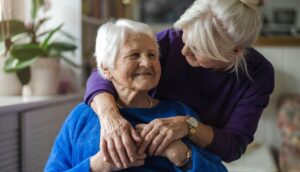
Mental health is a growing conversation in society today. We often talk about the struggles of teenagers, young adults, and professionals dealing with stress, anxiety, and burnout. But there’s one group that we might not pay attention to regarding mental health – our elderly parents. Aging brings several changes – loss of independence, declining health, social isolation, and even the passing of friends or a spouse. These factors can contribute to feelings of sadness that, when persistent, turn into depression.
As a child, you may have always looked to your parents for support and strength. But as they age, the roles reverse. It becomes your responsibility to notice when they’re struggling emotionally and help them deal with it.
This guide will help you explore ways to support your parent and offer resources that can make a real difference.
1. Seeking Professional Help When Necessary
While family support plays an essential role, there are times when professional help is the best course of action. If your parent’s depression seems persistent, interferes with their daily life, or leads to thoughts of self-harm, seeking guidance from a mental health professional is critical. A licensed therapist or counselor can help them work through emotions and develop coping strategies tailored to their situation.
Encouraging your parent to see a counselor can be tricky, especially if they’re resistant to the idea. Approach the conversation with patience and understanding. Rather than making them feel like something is “wrong” with them, frame it as an opportunity to talk to someone who understands their feelings and can offer tools to help them feel better.
If you have a personal passion for mental health, this may even be an opportunity to take a deeper interest in the field. You can find some of the cheapest CACREP-accredited programs online that can help you gain the knowledge needed to support not just your parent but others facing similar struggles.
2. Encouraging Social Connections
One of the biggest contributors to depression in seniors is loneliness. As people age, their social circles tend to shrink due to retirement, relocation, or the passing of close friends and family members. Without regular social interaction, feelings of isolation can set in, making depression worse. That’s why encouraging your parent to stay socially engaged is so important.
Help them reconnect with old friends or introduce them to new social opportunities. Community centers, religious gatherings, book clubs, and senior groups can provide valuable interaction. If mobility is an issue, technology can be a great alternative. Teaching them how to use video calls, social media, or even online forums can help them maintain relationships and feel connected.
Family involvement is just as important. Regular visits, phone calls, or even planning simple outings together can cheer them up.
3. Creating a Routine for Stability
Aging often brings unexpected changes, and for many seniors, a lack of structure can contribute to feelings of purposelessness. Having a daily routine provides a sense of stability, which can ease anxiety and improve overall well-being. A structured day doesn’t have to be rigid, but it should include a mix of activities that keep the mind and body engaged.
Encourage a morning routine that includes a healthy breakfast, light exercise, or even a simple task like watering plants. Scheduled activities throughout the day, such as reading, listening to music, or engaging in a hobby, can give them something to look forward to.
If your parent struggles with motivation, consider participating in activities with them. Whether it’s cooking together, going for a short walk, or watching a favorite show, your involvement can make routines feel less like a chore and more like an enjoyable part of their day.
4. Promoting Physical Activity
Exercise isn’t just about physical health—it’s one of the most effective natural treatments for depression. Physical activity releases endorphins, which help boost mood and reduce stress. The problem is that many seniors are either hesitant to exercise or unsure of where to start.
The key is to introduce activities that feel manageable and enjoyable. Walking is one of the simplest and most beneficial forms of exercise. Even a short walk around the neighborhood can improve circulation, reduce stiffness, and boost mental clarity. For those with limited mobility, chair exercises, stretching, or light yoga can be great alternatives.
5. Helping Them Find Purpose Again
One of the biggest struggles for seniors is a loss of purpose. Retirement, reduced independence, and losing loved ones can make them feel like they no longer have a meaningful role in life. Without a sense of purpose, depression can deepen. Finding new reasons to wake up each day can make all the difference.
Encourage them to engage in activities that bring fulfillment. Volunteering, mentoring younger generations, or even taking up a creative hobby like painting, writing, or music can give them a renewed sense of purpose.
If they have a passion for something they never had the time to pursue before, now is the perfect opportunity. Learning something new—whether it’s a language, an instrument, or a craft—can stimulate their mind and create excitement in their daily life.
6. Supporting Them Emotionally
Sometimes, the best thing you can do for your parent is simply to be there for them. Depression can make people feel isolated, even when surrounded by family. Your parent might not always openly express their feelings, but knowing they have someone who listens without judgment can make all the difference.
Validate their emotions rather than dismissing them. Avoid phrases like, “You have nothing to be sad about” or “Just think positive.” Instead, acknowledge what they’re feeling and let them know that it’s okay to struggle.
Small acts of kindness—like writing them a letter, surprising them with a thoughtful gift, or simply spending quality time together—can also boost their spirits. Emotional support doesn’t always require grand gestures; sometimes, the most meaningful thing you can do is just show up and let them know they’re not alone.
Supporting an elderly parent through depression is not an easy task, but it’s one of the most meaningful ways to show love and care. You need to be patient, observant, and proactive. If their condition is beyond your control, don’t hesitate to seek professional help.
Aging comes with its own challenges, but it doesn’t have to mean losing happiness. With the right support, your parent can navigate this stage of life with dignity, comfort, and a renewed sense of purpose.









